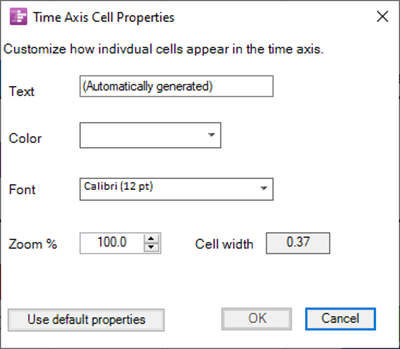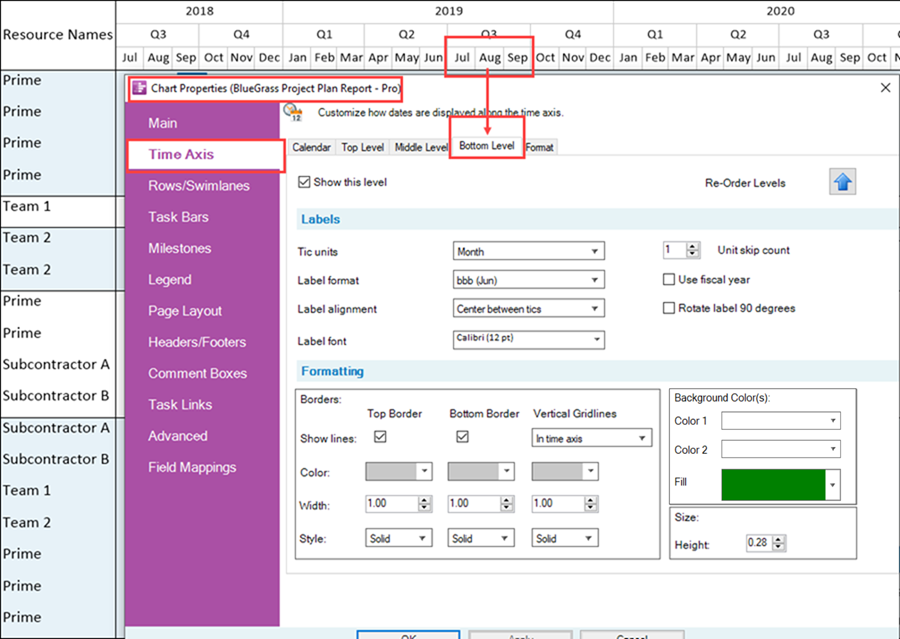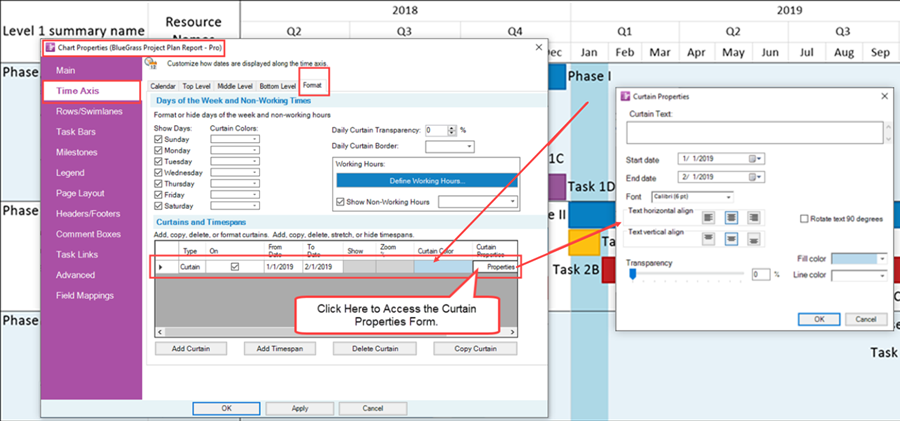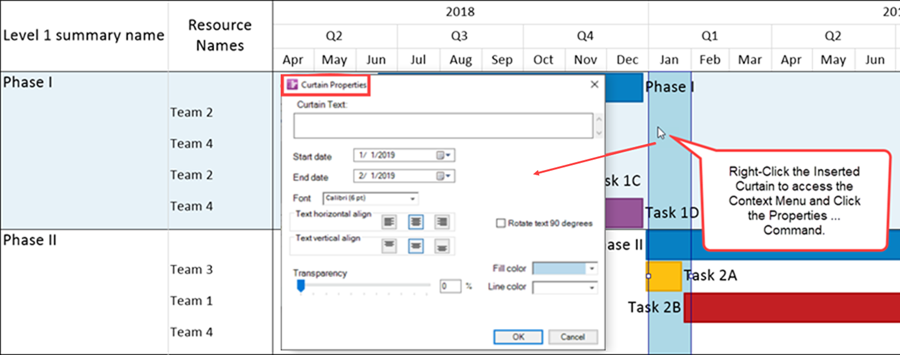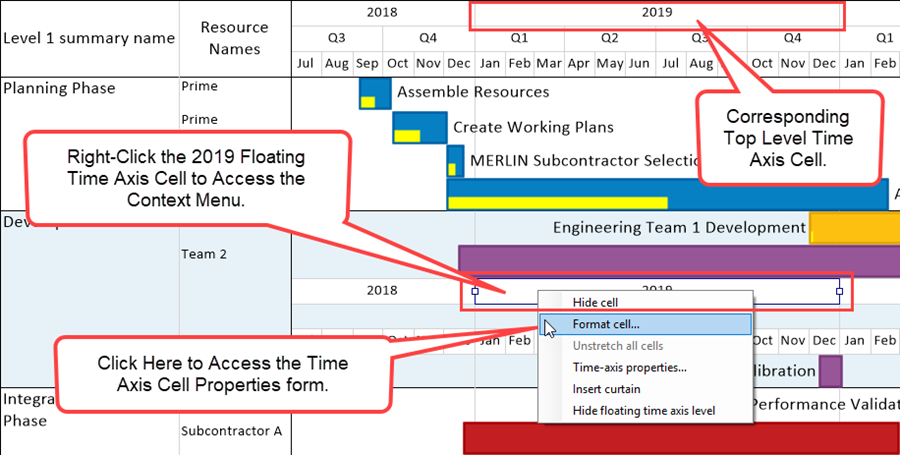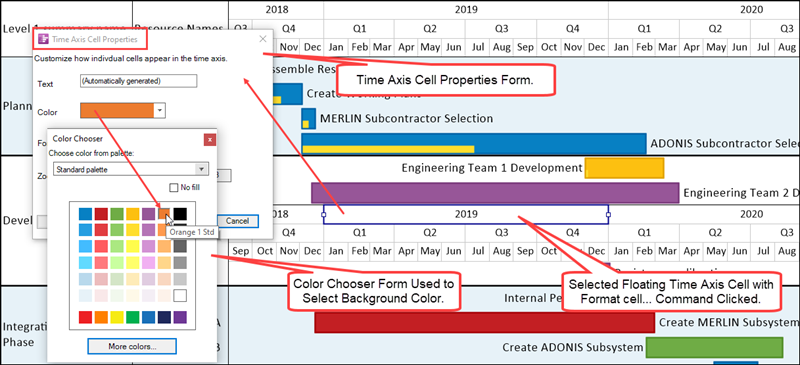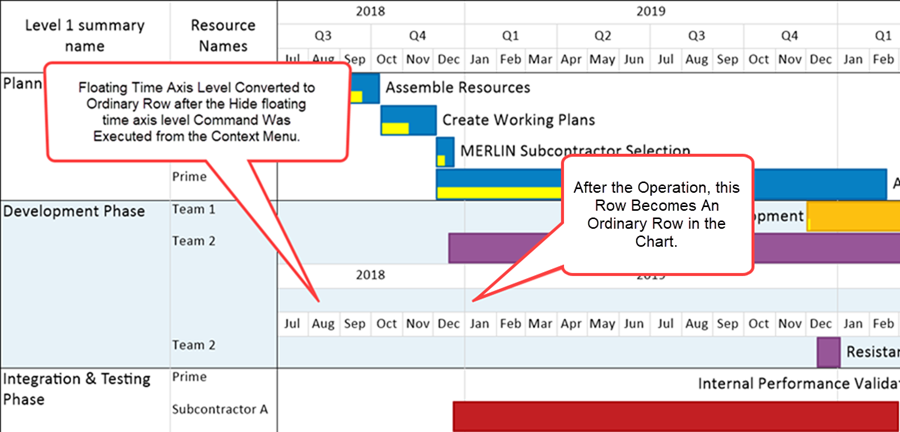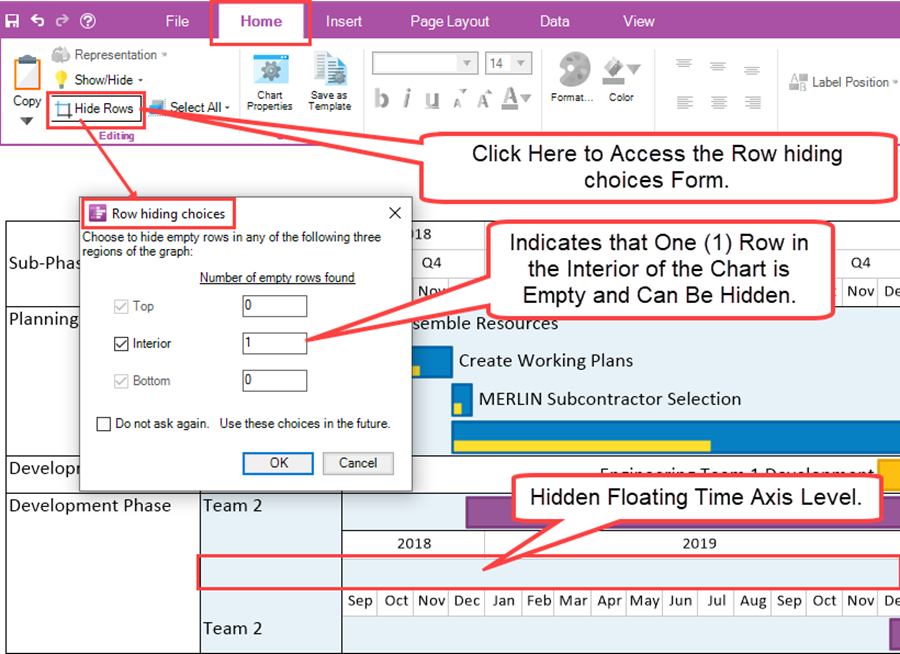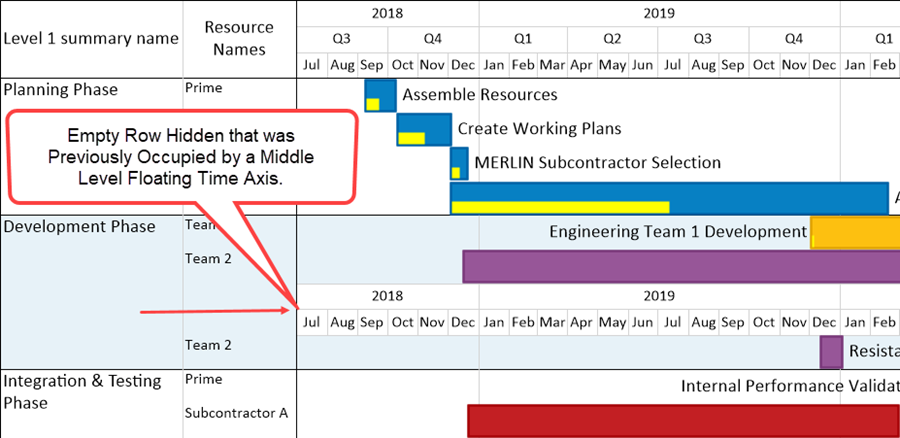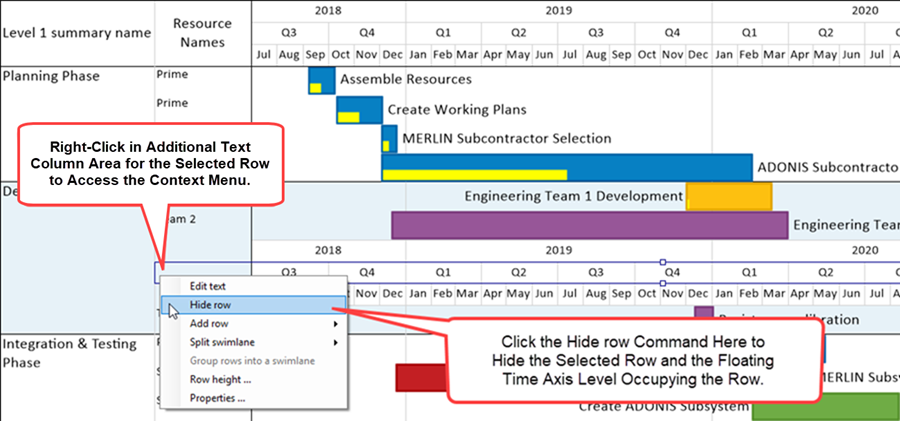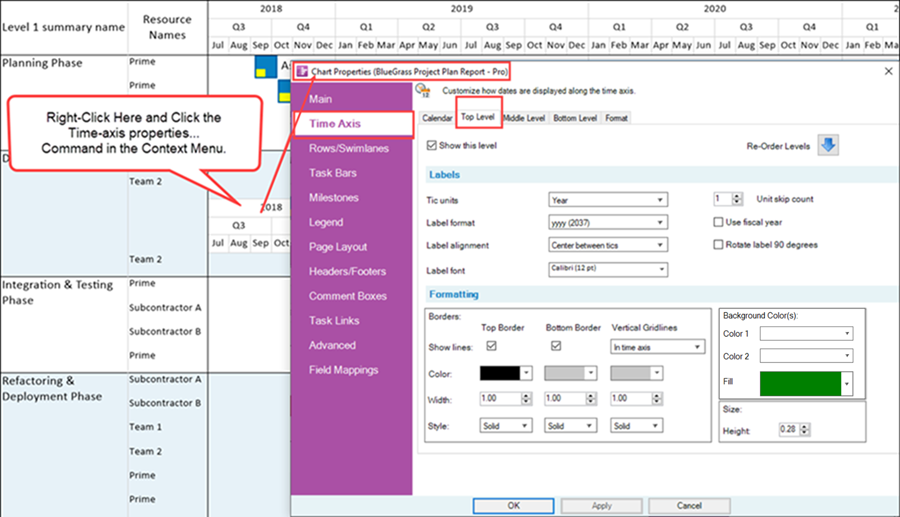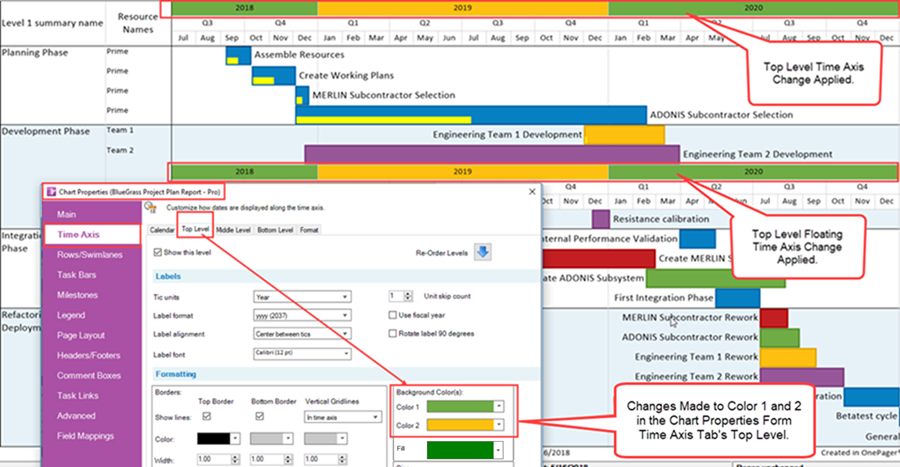Manual Editing the Time Axis for OnePager for Version 7.2
Contents
- 1 Overview
- 2 Selecting Time Axis Level Cells in the Chart Editor
- 2.1 Selecting Time Axis Level Cells with the Left-Click
- 2.2 Selecting Time Axis Level Cells with the CTL+Left-Click
- 2.3 Selecting Time Axis Level Cells with the SHIFT+Left-Click
- 2.4 General Rules for Using CTL+Left-Click and SHIFT+Left-Click on Time Axis Level Cells
- 2.5 Selecting Time Axis Level Cells with the Right-Click
- 3 Manually Hiding/Showing Individual Time Axis Level Cells
- 4 Related Links
Overview
Illustrations used in this article are from OnePager Pro using data from Microsoft Project but the features, function, controls, and manual edits apply equally to other OnePager editions that import from data sources like Microsoft Excel, Microsoft Project for the Web, Smartsheet, Oracle Primavera P6, Planisware Enterprise, Asana, and Wrike.
This article covers manual editing of the Time Axis and includes discussions of manual editing of Time Axis Level Cells from the Chart Editor and manual editing of Floating Time Axis Cells. Because the Time Axis Level Cell’s context menu contains commands related to the Non-Linear Time Axis feature and accessing the Chart Properties form, these topics are covered in this article as well. There are references placed throughout this article to related topics and a list of related articles is provided end of this article.
Please be aware that some manual edits performed on Time Axis Level Cell(s) causes entries to be placed in The Grid located in the Chart Properties form's Time Axis tab’s Format sub-tab.
The organization of this article follows the process of Time Axis Level Cell editing from the selection of the Time Axis Level Cell through the various methods available to edit Time Axis Cell properties in the Chart Editor.
Please use the hyperlinks in the Contents box at the top of this article to go directly to specific topics.
Selecting Time Axis Level Cells in the Chart Editor
Time Axis Level Cells can be selected with either a left-click which highlights the Cell or a right-click which provides access to the Time Axis Level Cell context menu. Multiple Cells can be selected in the same Time Axis Level using either the CTL+Left-Click to select non-contiguous Cells or Cells in different Time Axis Levels or the SHIFT+Left-Click to select contiguous Cells in the same Time Axis Level. Time Axis Level Cell(s) are selected to: (1) edit their show/hide status, (2) edit their width in the Time Axis Level manually, (3) edit certain Time Axis Level Cell properties, or (4) access the Chart Properties form Time Axis tab’s Level sub-tab to make more global edits.
Selecting Time Axis Level Cells with the Left-Click
Using the mouse left-click on any single Time Axis Level Cell highlights the Cell with the handlebars as shown below:

Once an individual Time Axis Level Cell is selected with the left-click you can either stretch or compress it from the left or from the right handlebar. Selected Time Axis Level Cells cannot be moved up or down from the Time Axis Level in which they reside.
However, Time Axis Levels can be re-ordered as described in the article at:
| Switching Time Axis Levels for OnePager
When the mouse button is released the Time Axis Levels look like this: <center>
Above, the Q1 Middle Time Axis Level Cell is stretched to approximately double its original width. Since the stretched Cell happens to be in the Middle Time Axis Level, the Cells showing below it in the Bottom Time Axis Level are stretched as well to maintain the related proportionality. In a similar fashion, the 2019 Top Level Time Axis Cell is stretched proportionally but the Q2, Q3, and Q4 Middle Time Axis Level Cells remain unchanged as does the remainder of the unaffected Time Axis Level Cells. Selecting Time Axis Level Cells with the CTL+Left-ClickYou can use your mouse to select Time Axis Level Cells in different Time Axis Levels by using the CTL+Left-Click method as shown here:  Above, there are five (5) Time Axis Level Cells selected in the order shown. Although there are five (5) Time Axis Level Cells selected above, you can only stretch or compress selected Cell using the Drag and Drop method in one Time Axis Level only as shown below:  If you now use the mouse to stretch the 2019 Q2 Middle Time Axis Level Cell, OnePager Pro de-selects all selected Time Axis Level Cells highlighted in other Time Axis Levels such that only the Middle Time Axis Level Cells that are candidates for stretching remain selected as shown here:  On the other hand, if you start to stretch the Bottom Level Time Axis Cells, OnePager Pro de-selects the Middle Level Time Axis Cells before performing the desired stretch as shown below:  Selecting Time Axis Level Cells with the SHIFT+Left-ClickYou can also select a sequential set of Time Axis Cells in the same Level by using the SHIFT+Left-Click keys as shown below:  Once the Time Axis Level Cells are selected, anyone of them can be used to stretch or compress the set as shown here:  The general rule is that you cannot stretch multiple Time Axis Level Cells that are selected in multiple Time Axis Levels. General Rules for Using CTL+Left-Click and SHIFT+Left-Click on Time Axis Level CellsUsing a combination of the CTL+Left-Click and the SHIFT+Left-Click is restricted. The rules provided below are used by OnePager to coordinate the selection of Time Axis Level Cells. You can use the CTL+Left-Click to select any Time Axis Level Cell in any Level. However, attempting to stretch a single Time Axis Level Cell when Cells are selected in two or more Levels results in only the selected Cell being stretched. The selected Time Axis Level Cells in other Levels are de-selected. You can use the SHIFT+Left-Click to select a series of Time Axis Level Cells that are all in the same Level. This results in a contiguous series of Time Axis Level Cells being selected all of which can be edited as one or stretched or compressed together. When you have a contiguous series of Time Axis Level Cells selected you can right-click on any one of them to access the context menu. You can use the CTL+Left-Click in multiple Time Axis Levels and then any attempts to utilize the SHIFT+Left-Click only works if the contiguous Time Axis Level Cells being selected are in one Time Axis Level. Attempting to use the SHIFT+Left-Click across two or more Levels is not honored. For example, suppose you use the CTL+Left-Click to select several Cells each in the Bottom Level Time Axis and the Middle Level Time Axis all the while holding the CTL key down. This results in the two Levels being selected. Attempting to use the SHIFT+Left-Click in either the Bottom Level or the Middle Level Time Axes results in contiguous Cells being selected. If, however, after multiple Time Axis Level Cells are selected in the Bottom and Middle Time Axis Levels, attempting to use the SHIFT+Left-Click in the Top Level Time Axis is not honored although the previously selected Cells remain selected. Selecting Time Axis Level Cells with the Right-ClickIf you use the mouse right-click on a Time Axis Level Cell, the action accesses the time axis right-click context menu shown below:  The context menu above has five (5) commands of which four (4) are always enabled. The Unstretch all cells command is enabled when at least one (1) Time Axis Level Cell is stretched or compressed. The sections that follow cover the five (5) context menu commands and associated topics. Manually Hiding/Showing Individual Time Axis Level CellsThe hiding/showing of individual Time Axis Level Cells feature is useful in schedule presentation situations where you want to hide portions of the chart that are not relevant to the schedule issues you want to present. Time Axis Level Cells as well as Floating Time Axis Level Cells can be Hidden by manually selecting one or more Cells with left-clicks and then right-clicking on a selected Cell(s) to access the time axis right-click context menu shown below:  Clicking the Hide cell command in the above context menu makes the three selected Bottom Time Axis Level Cells disappear from the chart along with portions of the task bars/milestone symbols occupying the timespan being hidden. The result of clicking the Hide cell command looks like this:  Using The Grid with Hidden Time Axis Level CellsAs a record of this action, entries are placed in The Grid as shown below: 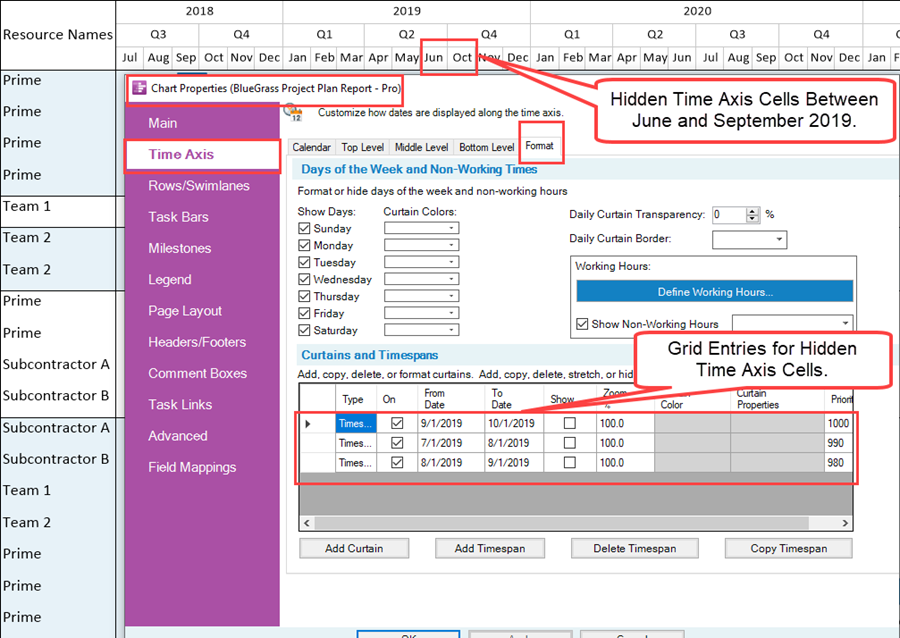 The Grid above keeps a record of Hidden Time Axis Level Cells and is enabled in the sense that you can restore visibility of Hidden Time Axis Level Cells by checking one or more of the Show column checkboxes. Turing OFF the rules, so to speak, by unchecking the ON column checkbox to OFF has the same effect; that is, the Hidden Time Axis Level Cell is then shown. The Zoom% is established at the time the chart is created at 100% for all Time Axis Level Cells. If a Timespan is entered into The Grid, the entry’s Zoom% is set initially to 100%. Thereafter, the Zoom% is calculated based upon the original Width of the Time Axis Level Cell regardless if the Width of a Cell is edited by the drag and drop method, or edited in The Grid’s Zoom% column. Editing the Zoom% value for an entry in The Grid has an effect only after the Hidden Time Axis Level Cell’s Show/Hide status is edited to Show by the checking of the Show column checkbox for that entry. If you enter a Zoom% value of zero (0) or a negative value, OnePager Pro resets Zoom% value for the Cell to 2.0 percent. Likewise you cannot create a Zoom% greater than 1,000%. As can be seen in the above The Grid, the columns that have their entries disabled cannot be edited. The Priority column in The Grid only applies to Timespan entries. It is used to keep track of the order that Timespans are manually stretched or compressed in the chart. The Priority column helps OnePager perform the Unstretch all cells command in the proper order. The Add, Delete, and Copy Timespan controls are available for creating and editing Timespans in The Grid. Since The Grid is also used to create, edit, and track Curtains, the commands beneath The Grid’s window change to reflect the entry selected. The dates used in The Grid to define the timespan include not only the date for From/To Dates but the time of day as well. If you just specify dates, OnePager assumes that the From Date starts at midnight on that day and the To Date ends before midnight on that day. To completely specify the timespan for a Time Axis Level Cell to be hidden it is important to make sure that the timespan is complete. As an example, to hide the month of January 2019 the From Date should be 1/1/2019 and the To Date should be 2/1/2019 as shown here: 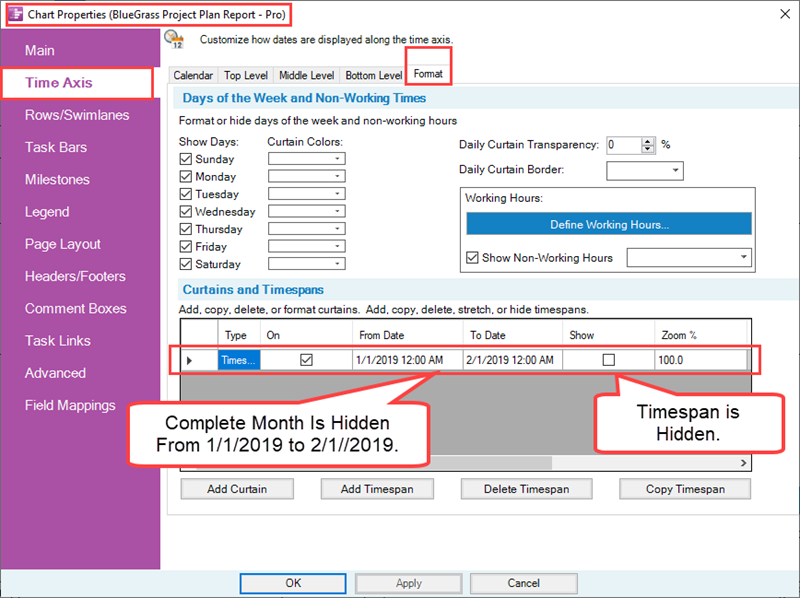 Restoring Hidden Time Axis Level CellsWhen Time Axis Level Cells are Hidden on any Time Axis Level, they can be restored to visibility in several ways. First, you can go to the OnePager Home ribbon tool bar tab in the Editing group and click on the Show/Hide dropdown and click the Show All Time Axis Cells command as shown below: 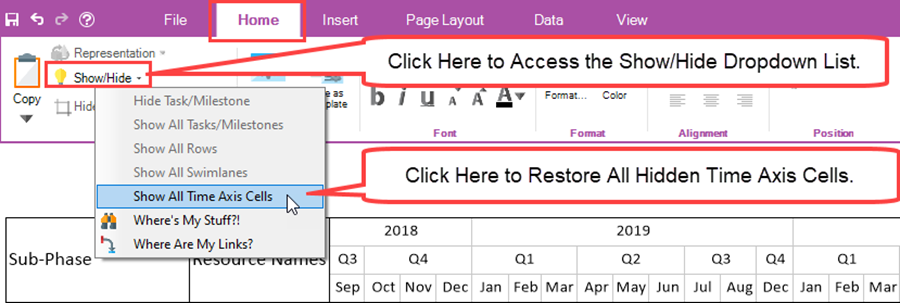 Exercising the above action also clears (removes) all Timespan entries in The Grid. Second, you can also use The Grid to restore some or all Hidden Time Axis Level Cells to visibility by checking the desired entry’s Show column checkbox as shown here: 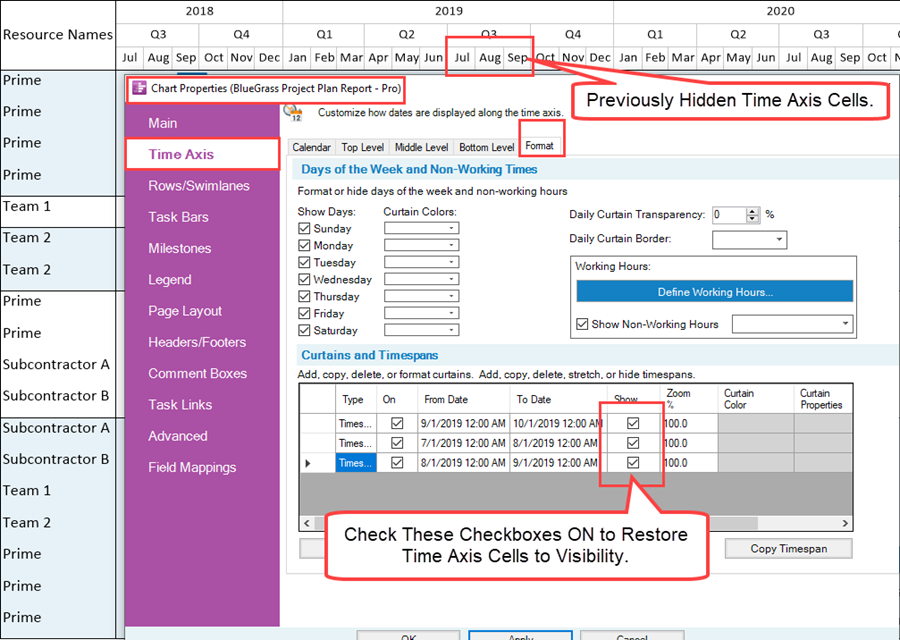 Using The Grid method above restores visibility to the Hidden Time Axis Level Cells and retains the entries in The Grid which can be useful for future edits. Finally, unchecking the ON checkbox to OFF in The Grid turns OFF the entry rule thereby restoring the selected Timespans to visibility while retaining the entry in The Grid as shown below: 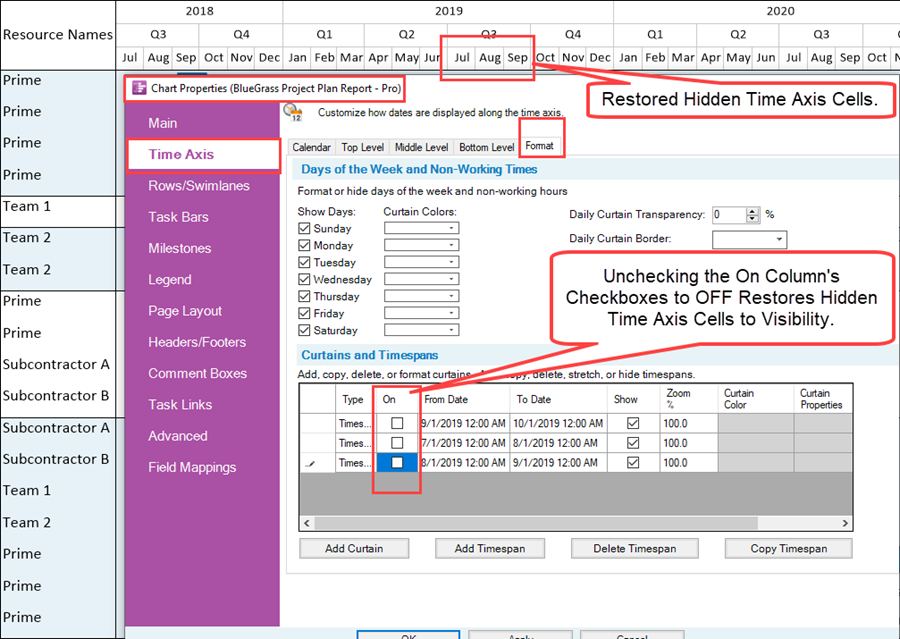 If there are hidden Time Axis Level Cells in a Hidden Time Axis Level (Show this level checkbox in the Chart Properties form Time Axis tab’s various Level sub-tabs was unchecked or OFF), clicking the Show All Time Axis Cells in the OnePager Home ribbon tool bar tab's Editing group’s Show/Hide dropdown does NOT restore hidden Time Axis Level to the show status. In other words, to restore hidden Time Axis Level Cells, the Time Axis Level containing the hidden Time Axis Level Cells must be shown in the chart. However, after the Show All Time Axis Cells command is executed, and barring any further hiding of Time Axis Level Cells, when the hidden Time Axis Level is again shown all previously hidden Cells are visible. For more information on hiding/showing Time Axis Level Cells, please see the article at:
|

